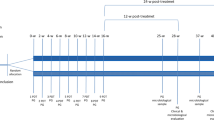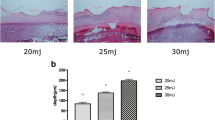Abstract
Onychomycosis is a fungal infection of the nail. The aim of this randomized controlled clinical trial was to compare the efficacy of 2940-nm Er:YAG laser treatment combined with a 5% amorolfine lacquer versus amorolfine monotherapy for treating onychomycosis. In this study, patients with onychomycosis of the great toenail were randomly assigned to a combination therapy group and a monotherapy group. In the combination therapy group, the included toenails were treated with a fractional 2940-nm Er:YAG laser at weeks 1, 2, 3, 4, 8, and 12, combined with a 5% amorolfine lacquer twice a week for 12 weeks, while in the monotherapy group, the included toenails were treated with only a 5% amorolfine lacquer twice a week for 12 weeks. The onychomycosis severity index (OSI) score and the mycological clearance rate (MCR) of the included toenails were assessed at baseline, week 12, and week 24. At weeks 12 and 24, the great toenails with mild and moderate onychomycosis in the combination therapy group showed obvious improvement and a greater decrease in OSI than those in the monotherapy group. At week 24, the toenails with mild and moderate onychomycosis in the combination therapy group also showed a better MCR. For the toenails with severe onychomycosis, little improvement was observed in either group at week 12 or week 24. In conclusion, fractional 2940-nm Er:YAG laser treatment combined with a 5% amorolfine lacquer is more effective than amorolfine monotherapy in short-term improvement of onychomycosis.


Similar content being viewed by others
References
Lipner SR, Scher RK (2019) Onychomycosis: treatment and prevention of recurrence. J Am Acad Dermatol 80:853–867
Gupta AK, Versteeg SG, Shear NH (2017) Onychomycosis in the 21st century: an update on diagnosis, epidemiology, and treatment. J Cutan Med Surg 21:525–539
Dürrbeck A, Nenoff P (2016) Terbinafine : relevant drug interactions and their management. Hautarzt 67:718–723
Eertmans F, Doss N, Rossel B, Adriaens E (2018) Daily application of an aqueous, acidifying, peelable nail polish versus weekly amorolfine for topical onychomycosis treatment: a prospective, randomized, blinded trial. Dermatol Ther (Heidelb) 8:463–473
Monti D, Saccomani L, Chetoni P, Burgalassi S, Senesi S, Ghelardi E et al (2010) Hydrosoluble medicated nail lacquers: in vitro drug permeation and corresponding antimycotic activity. Br J Dermatol 162:311–317
El-Tatawy RA, Aliweh HA, Hegab DS, RAZ T, Shams EMA (2019) Fractional carbon dioxide laser and topical tioconazole in the treatment of fingernail onychomycosis. Lasers Med Sci 34:1873–1880
Zhang J, Lu S, Huang H, Li X, Cai W, Ma J et al (2016) Combination therapy for onychomycosis using a fractional 2940-nm Er:YAG laser and 5 % amorolfine lacquer. Lasers Med Sci 31:1391–1396
Carney C, Tosti A, Daniel R, Scher R, Rich P, DeCoster J et al (2011) A new classification system for grading the severity of onychomycosis: onychomycosis severity index. Arch Dermatol 147:1277–1282
Lim EH, Kim HR, Park YO, Lee Y, Seo YJ, Kim CD et al (2014) Toenail onychomycosis treated with a fractional carbon-dioxide laser and topical antifungal cream. J Am Acad Dermatol 70:918–923
Zhou BR, Lu Y, Permatasari F, Huang H, Li J, Liu J et al (2016) The efficacy of fractional carbon dioxide (CO2) laser combined with luliconazole 1% cream for the treatment of onychomycosis: a randomized, controlled trial. Medicine (Baltimore) 95:e5141 controlled trial. Medicine (Baltimore) 95:e5141
Monti D, Tampucci S, Chetoni P, Burgalassi S, Mailland F (2014) Ciclopirox vs amorolfine: in vitro penetration into and permeation through human healthy nails of commercial nail lacquers. J Drugs Dermatol 13:143–147
McAuley WJ, Jones SA, Traynor MJ, Guesné S, Murdan S, Brown MB (2016) An investigation of how fungal infection influences drug penetration through onychomycosis patient’s nail plates. Eur J Pharm Biopharm 102:178–184
Sardana K, Ghunawat S (2015) Lasers for Lentigines, from Q-switched to erbium-doped yttrium aluminium garnet micropeel, is there a need to reinvent the wheel. J Cutan Aesthet Surg 8:233–235
Pittrof F, Gerhards J, Erni W, Klecak G (1992) Loceryl nail lacquer--realization of a new galenical approach to onychomycosis therapy. Clin Exp Dermatol 17(Suppl 1):26–28
López A, Llinares F, Cortell C, Herráez M (2000) Comparative enhancer effects of Span20 with Tween20 and Azone on the in vitro percutaneous penetration of compounds with different lipophilicities. Int J Pharm 202:133–140
Kobayashi Y, Miyamoto M, Sugibayashi K, Morimoto Y (1999) Drug permeation through the three layers of the human nail plate. J Pharm Pharmacol 51:271–278
Funding
This study was supported by the Sun Yat-sen Clinical Research Cultivating Program (SYS-Q-201705) from Sun Yat-sen Memorial Hospital.
Author information
Authors and Affiliations
Corresponding author
Ethics declarations
Disclaimer
This funding body did not provide any direction to the current study design; collection, analysis, or interpretation of data; the writing of the manuscript; and the decision to submit the manuscript for publication.
Conflict of interest
The authors declare that they have no conflict of interest.
Ethical approval
This study was approved by the Ethics Committee of Sun Yat-sen Memorial Hospital (ethical number 2017018) and in accordance with the 1964 Helsinki declaration and its later amendments or comparable ethical standards.
Informed consent
The written informed consent approved by the Ethics Committee of Sun Yat-sen Memorial Hospital was obtained for all study participants prior to study participation.
Additional information
Publisher’s note
Springer Nature remains neutral with regard to jurisdictional claims in published maps and institutional affiliations.
Rights and permissions
About this article
Cite this article
Zhang, J., Zhang, Y., Qin, J. et al. Comparison of a fractional 2940-nm Er:YAG laser and 5% amorolfine lacquer combination therapy versus a 5% amorolfine lacquer monotherapy for the treatment of onychomycosis: a randomized controlled trial. Lasers Med Sci 36, 147–152 (2021). https://doi.org/10.1007/s10103-020-03054-7
Received:
Accepted:
Published:
Issue Date:
DOI: https://doi.org/10.1007/s10103-020-03054-7




